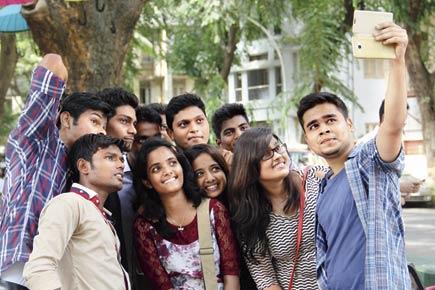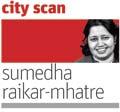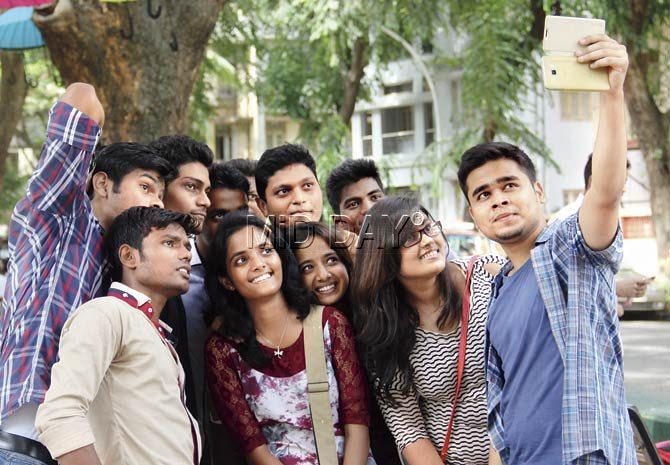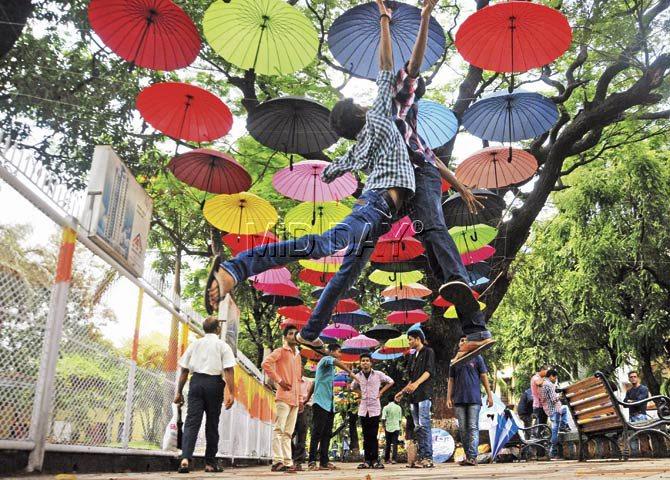A selfie point shatters the calm of a park, and may be symbolic of a wider trend of skirting bigger issues by using a quick-fix method to appease the electorate

 In a traffic-congested, hawker-infested, crowded Mumbai, Shivaji Park in Dadar stands out as a large green public space (27.907 acres) offering the delights of walking. Morning joggers and evening walkers make a pretty picture alongside the 1.17 kilometre circumference of the historic 90-year-old park.
In a traffic-congested, hawker-infested, crowded Mumbai, Shivaji Park in Dadar stands out as a large green public space (27.907 acres) offering the delights of walking. Morning joggers and evening walkers make a pretty picture alongside the 1.17 kilometre circumference of the historic 90-year-old park.
At the core of the Park is the famed ground for cricket and football practice, whereas the periphery is dotted by a sports gymkhana, a children’s corner, a senior citizens’square, two Hindu temples, a scouts pavilion and a gymnasium.
ADVERTISEMENT

Ellen de Generes (in white suit) and the selfie at the Oscars that was a global rage
The latest feature added to the park has attracted unusual attention a ‘selfie point’ where visitors photograph themselves against colourful hanging umbrellas and installations. Ever since its inauguration on June 18, the selfie point has allured the young and the old visitors of the Park, particularly over the weekends and public holidays.

A group of friends click a picture at Shivaji Park. Pic/Sharad Vegda
Feel-good is the point
Apparently, a selfie point seems a cool hangout place which encourages dissemination of happy self-images across social media platforms. Selfie poses before a smartphone camera add colour and humour to the diverse conversations unfolding in a public park, feels Sandeep Deshpande, the municipal corporator who has taken the initiative to shape the selfie point. Deshpande is an elected representative of the Maharashtra Navnirman Sena (MNS), a political outfit which enjoys considerable clout in the Shivaji Park area.

People gather to click pictures at this ‘selfie point’ at Shivaji Park, Dadar. Pic/Satyajit Desai
Side please, I want to walk
While the MNS is happy to promote a ‘cool’ teen trend fueled by smartphone technology, a set of serious walkers are unhappy about the selfie/groupie crowd that obstructs their walking. Shivaji Park attracts walkers from far-off parts of Mumbai (not necessarily Central Mumbai) because of the sheer paucity of parks in the city.
It is one of the rare large stretches where walkers seek health benefits without much special equipment or athletic skills. Walkers’ efforts are geared towards a health agenda, losing weight, lifting moods, controlling diabetes or lowering blood pressure.
Selfie sticks do not have a place in the walkers’ universe. In fact, selfie sticks are a physical threat to the walkers because they congest the walking track. Sticks, cameras, tripods, monopods, smartphones jutting out in the face of strollers can cause accidents.
Not just physical
It is not just the physical inconvenience that the walkers object to. The selfie point is an easy low-cost populist measure which does not requires minimal infrastructural investment on the part of the political outfit which has drawn publicity out of a non-issue.
At a time when the park area residents are facing several other serious issues like rising noise pollution, depletion of the playground top soil and nightlife insecurity there is no place for escapist selfies, that too at the cost of the walkers of the park.
While projecting the selfie point as a great step to create a community feel in the Park, the MNS is actually evading tough issues. And it is not just the MNS, but elected representatives of all political parties (with no exception to the rule) have not dealt with the larger causes of urban governance and metropolitan planning.
A walker states, “To install wi-fi facilities in the Park or to create a selfie corner is an easier and glamourous option as against taking up cudgels with the larger market forces which are altering the face of Mumbai.” Many Park residents feel that this selfie point symbolises the end of substantive politics. Elected representatives, in a bid to be seen as pro-people and proactive, are choosing quick-fix stunts to appease their electorate.
Selfie sure
Selfie points are symbolic of our collective and decisive surrender to social media.
The humongous exchange of flattering self-images on social media across Facebook, Twitter and Instagram has worried social scientists the world over. The ‘selfie’ is seen as a ‘braggie’ narcissistic act where an insignificant private moment at a random place is shared (out of context) with friends and strangers online. It is not just the clicking of the image but the resultant obsessive need to share online that is being examined by psychologists.
Selfies have become a form of expression, a medium to seek validation and appreciation in the virtual world. In the recent book The Allure of the Selfie: Instagram and the New Self Portrait, Brooke Wendt dissects the pop-culture self-obsession.
Wendt says, “The notion of becoming greater through images may explain our need to document and then stylize every second of our being: we want to appear significant, and we look to our image to signify this fact to us.”
Trapped in falsehoods
The book warns against the creation of false virtual environments which limit ourselves and alter our self-awareness. “Trapped by the lure of an ideal self, we produce a never-ending cycle of selfies with different looks and hashtags. We lose ourselves inside a program of possibilities, as we capture, edit, and share our selfies from our mobile devices.” Incidentally, selfie is amongst the 10 most-searched words on the Internet.
Just making a point
The selfie mania is a widespread global phenomenon, naturally beyond the opinion or control of a single individual. But a self-obsessive trend, that cannot be curbed, need not be encouraged.
It would be nice to review the various public spaces all over the world where selfies have been banned for security and safety reasons. The Eiffel Tower in France and the Smithsonian Museums in the US have banned the selfie sticks because they messed up with the dignity of the place.
All Disney parks have banned selfie sticks on their grounds. South Korea is cracking down on unregistered selfie sticks and will now regulate them through an agency watching telecom devices. Meanwhile, New York is the first state in America to outlaw people taking pictures of themselves with zoo animals. A number of dangerous ‘tiger selfies’ prompted a bill against the selfies.
Shantata! Ithe Park Ahe!
Just as public parks are meeting places for friends and family, they are also pockets that encourage reflection and inner silence. Parks grant me-time to harried and hurried residents. They are spaces cut off from the rigmarole of the routine. They liberate the residents, temporarily, from daily stress.
Since a park serves such vital functions and gives us moments to rejoice, we also need to give back something to the park. And a return gift in the form of a crowded cacophonous selfie spot is not welcome. Perhaps, a silent walk is a more deserving tribute to Shivaji Park.
The writer is a Mumbai-based culture chronicler.
 Subscribe today by clicking the link and stay updated with the latest news!" Click here!
Subscribe today by clicking the link and stay updated with the latest news!" Click here!







